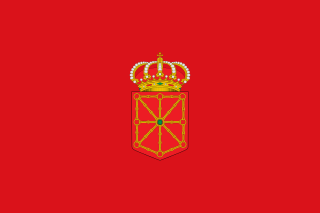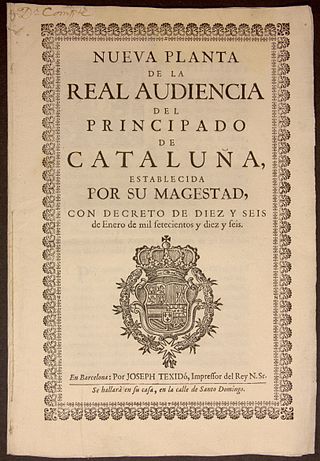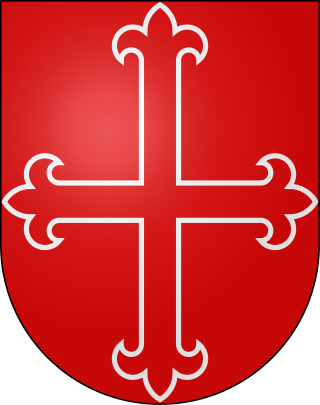
Navarre, officially the Chartered Community of Navarre, is a landlocked foral autonomous community and province in northern Spain, bordering the Basque Autonomous Community, La Rioja, and Aragon in Spain and New Aquitaine in France. The capital city is Pamplona. The present-day province makes up the majority of the territory of the medieval Kingdom of Navarre, a long-standing Pyrenean kingdom that occupied lands on both sides of the western Pyrenees, with its northernmost part, Lower Navarre, located in the southwest corner of France.

Lower Navarre is a traditional region of the present-day French département of Pyrénées-Atlantiques. It corresponds to the northernmost region of the Kingdom of Navarre during the Middle Ages. After the Spanish conquest of Iberian Navarre (1512–24), this merindad was restored to the rule of the native king, Henry II. Its capitals were Saint-Jean-Pied-de-Port and Saint-Palais. In the extreme north there was the little sovereign Principality of Bidache, with an area of 1,284 km2 (496 sq mi) and a decreasing population of 44,450, 25,356.

The Kingdom of Navarre, originally the Kingdom of Pamplona occupied lands on both sides of the western Pyrenees, with its northernmost areas originally reaching the Atlantic Ocean, between present-day Spain and France.

Fuero, Fur, Foro or Foru is a Spanish legal term and concept. The word comes from Latin forum, an open space used as a market, tribunal and meeting place. The same Latin root is the origin of the French terms for and foire, and the Portuguese terms foro and foral; all of these words have related, but somewhat different meanings.

The Nueva Planta decrees were a number of decrees signed between 1707 and 1716 by Philip V, the first Bourbon King of Spain, during and shortly after the end of the War of the Spanish Succession by the Treaty of Utrecht.

The Southern Basque Country refers to the Basque territories southside of the Pyrenees, within the Iberian Peninsula.

Medrano is a Spanish surname of Basque origin that means "abundance, to grow, to prosper, or to improve." It is a surname of high nobility established in the old Kingdoms of Navarre, Aragon, Castile, France, etc. They are all descendants of their progenitor, Prince Andrés Vélaz de Medrano.

The Spanish conquest of the Iberian part of Navarre was initiated by Ferdinand II of Aragon and completed by his grandson and successor Charles V in a series of military campaigns lasting from 1512 to 1524. Ferdinand was both the king of Aragon and regent of Castile in 1512. When Pope Julius II declared a Holy League against France in late 1511, Navarre attempted to remain neutral. Ferdinand used this as an excuse to attack Navarre, conquering it while its potential protector, France, was beset by England, Venice, and Ferdinand's own Italian armies.
The General Assemblies is the name of the legislative body (legislature) of the Spanish Basque territories of Biscay, Gipuzkoa, Alava and Navarre, and the elected assemblies to which the Government of each territory is responsible. The northern, French Basque Country, had its own regional assemblies until the Napoleonic period.

Amaiur-Maya is a village in the municipality of Baztan in the autonomous region of Navarre in Spain. It is situated in the Pyrenees mountain range close to the border with France.
The end of Basque home rule or fueros in Spain was a process coming to a head in the period extending from the First Carlist War (1833-1840) to the aftermath of the Third Carlist War (1876-1878). It brought to an end the status of sovereignty coupled with allegiance to the Crown of Castile held by the different Basque territories for centuries. In the French Basque Country, home rule was abruptly suppressed during the French Revolution.

Juan Martínez de Medrano y Aibar, nicknamed the Elder, was the regent of the Kingdom of Navarre from 13 March 1328 until 27 February 1329, a judge of the Navarrese Cortés, Baron and Lord of Arroniz, Sartaguda, Viana, Fontellas, Monteagudo, and Villatuerta, ricohombre of Navarre, a significant representative of the ricoshombres and estates of the realm and the lieutenant of the Governor of Navarre from 1329–1330. Juan Martínez de Medrano y Aibar was a prominent figure of the Navarrese high nobility and main head of his lineage. Juan participated in the most relevant political events that occurred in the Kingdom of Navarre in the first half of the 14th century.

Juan Vélaz de Medrano IV was the royal chamberlain for King Charles III of Navarre in 1414 and King John II of Aragon and Navarre in 1432. Juan was a noble, ricohombre and knight from the Kingdom of Navarre. He was the baron and lord of Igúzquiza, Arguiñano, Arzoz, Artazu, Zabal, Orendáin, the 1st lord of Learza and the alcaide of Monjardín Castle and Viana. In 1437, Juan founded the Mayorazgo of Vélaz de Medrano, the oldest hereditary mayorazgo in Viana, Spain.

The Palace of Vélaz de Medrano is the former seat and residence of the noble Medrano family in Igúzquiza, Navarre. The palace was directly linked to the lordship of Igúzquiza, perpetually held by the Medrano family. The castle-palace of Vélaz de Medrano is currently privately owned and listed in the Spanish Historical Heritage, obtaining the protection of the generic declaration of the Spanish Historical Heritage decree on April 22, 1949, and protected by Law 16/1985 of June 25, 1985.

Jaime Vélaz de Medrano y Echauz was a nobleman from the House of Medrano, a Knight of Navarre, royal guard of King John III of Navarre, captain of the kings standing army, alcaide of the Castle of Maya and mayor of Amaiur-Maya. Medrano became one of the leading defenders of the Independent Navarrese crown against the Spanish conquest of Iberian Navarre. Jaime Vélaz de Medrano is believed to have served as the Alcaide of Maya Castle from 2 October 1521, to 19 July 1522.

José Joaquín Vélaz de Medrano y Gante, 1st Marquess of Fontellas 1st Viscount of Amaláin, 7th Viscount of Azpa, Lieutenant of the Royal Spanish Guards during the reign of Charles III of Spain, 14th Lord of Fontellas, 21st Lord of Autol and Yerga, 13th Lord of Quel de Suso, 13th Lord of Ordoyo, and Lord of the Towns and Palaces of Mendillorri and Beúnzalarrea, the town of Amaláin, Lavaiz and Villanueva. He was a Knight of the Order of Malta, representative to the General Courts for the Military Branch, magistrate of Pamplona and a member of the Cortes of Navarre. Medrano was created 1st Viscount of Amaláin and the 1st Marquess of Fontellas by Royal decree on April 19, 1793, by Charles IV of Spain. He was born in Pamplona and died unmarried in Fontellas on 10 February 1826. His nephew Fernando Vélaz de Medrano y Alava succeeded him as the II Marquess of Fontellas.

The Viscounts of Azpa were the rulers of the Viscountcy of Azpa. The Viscountcy takes its name from the town of Azpa, a locality and council located in the municipality of Valle de Egüés, in Navarre province, Spain. The Viscountcy of Azpa was granted by Philip II of Spain in the mid-16th century to Don Alonso Vélaz de Medrano Navarra y Liédena, who served as a captain of cavalry under Fernando Álvarez de Toledo y Pimentel, the 3rd Duke of Alba de Tormes. The Viscounts of Azpa, who were descendants of Queen Joan II of Navarre and King Philip III of Évreux, were later granted the title Marquess of Fontellas.

Juan Vélaz de Medrano y Mauleon y Navarra was a lord, nobleman and knight from the House of Medrano. Juan was the owner of the Palace of Vélaz de Medrano and the hereditary lord of Igúzquiza, Agos, Aguinano, Orendain, Zabala, Arroniz, and 5th lord of Learza during the reign of Charles V, Holy Roman Emperor. Juan Vélaz de Medrano was a descendant of Kings Henry I of Navarre from the House of Blois; Charles II of Navarre from the House of Évreux; and King Philip III of Navarre and Joan II, Queen of Navarre, from the House of Capet.

Juan Vélaz de Medrano y Echauz was a high ranking nobleman and military leader in the final years of an independent Kingdom of Navarre. Head of the ancient House of Medrano in Navarre and the Vélaz de Medrano mayorazgo, he was the Lord of Igúzquiza, Aguinano, Orendain, Zabala, Arróniz, the 4th Lord of Learza and the maternal great-great-great-grandson of Queen Joan II of Navarre and King Philip III of Navarre. He was appointed merino of the merindad of Estella, and became the governor of the castles of Del Castillo, Santacara, Monjardin. Juan was the Major Knight of King John III of Navarre and Henry II of Navarre. He became a vassal of Charles V, Holy Roman Emperor after the Spanish conquest of Navarre. Juan was a significant representative of the Agramontese faction, rivals of the Beaumontese.













